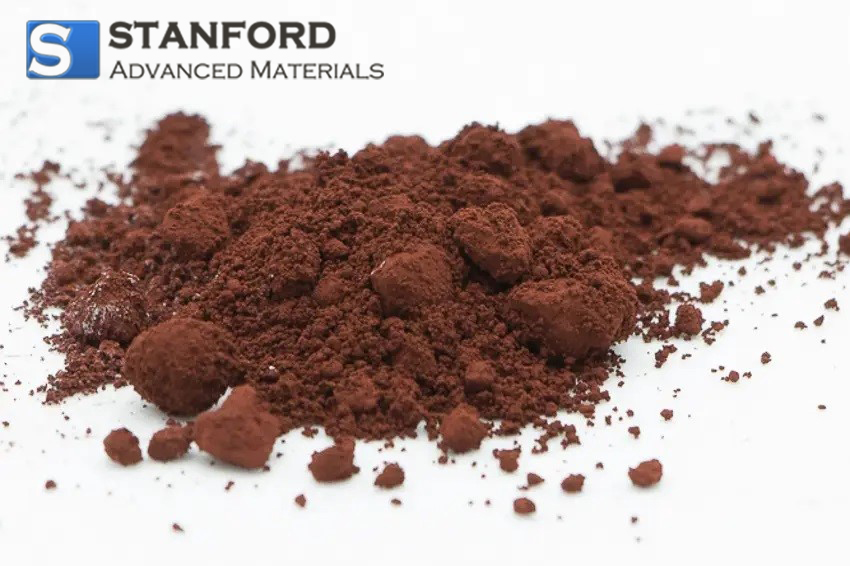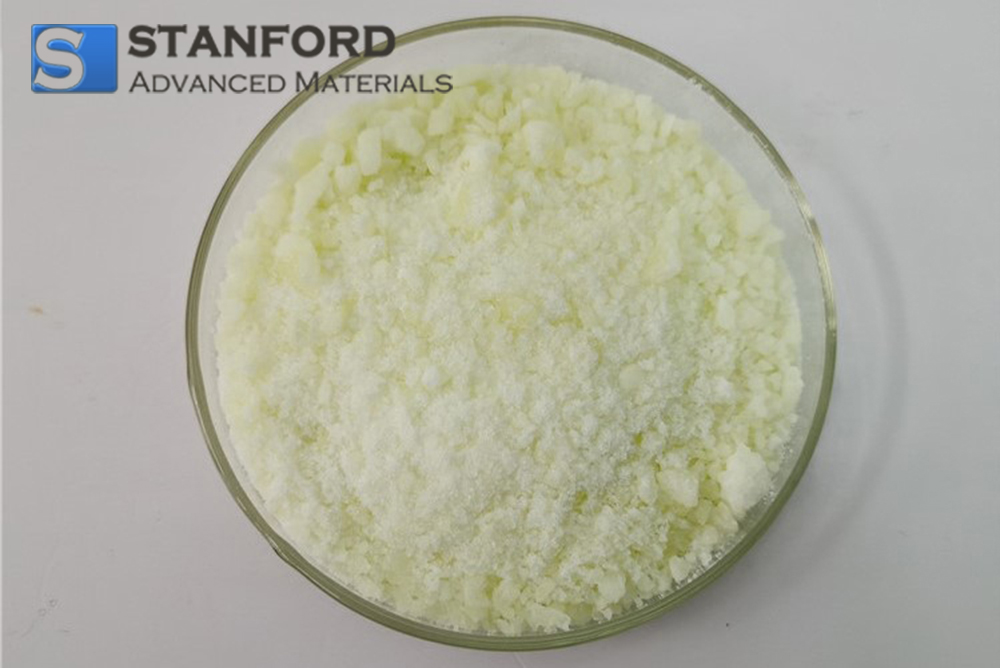DYSPROSIUM NITRIDE
Revision Date:2023-10-21 Revision Number:1
SECTION 1: Identification of the substance/mixture and of the company/undertaking
Product identifier
Product name: DYSPROSIUM NITRIDE
Catalog: NR1798
CAS Number: 12019-88-4
Synonyms : DYSPROSIUM NITRIDE
Relevant identified uses of the substance or mixture and uses advised against
Relevant identified uses Uses advised against
Company Identification: For R&D use only. Not for medicinal, household or other use.
Company: Stanford Advanced Materials
Address: 23661 Birtcher Dr., Lake Forest, CA 92630 U.S.A.
Telephone : (949) 407-8904
SECTION 2: Hazards identification
Classification of the substance or mixture
no data available
Label elements
Pictogram(s)
Signal word no data available
Hazard statement(s)
no data available
Precautionary statement(s)
Prevention
no data available
Response
no data available
Storage
no data available
Disposal
1
Disposal
no data available
Other hazards
no data available
SECTION 3: Composition/information on ingredients
Substance
Product name: DYSPROSIUM NITRIDE
Synonyms: DYSPROSIUM NITRIDE
CAS: 12019-88-4
EC number: 234-649-8
MF : DyN
MW : 176.51
SECTION 4: First aid measures
Description of first aid measures
If inhaled
Move the victim into fresh air. If breathing is difficult, give oxygen. If not breathing, give artificial respiration and consult a doctor immediately. Do not use mouth to mouth resuscitation if the victim ingested or inhaled the chemical.
Following skin contact
Take off contaminated clothing immediately. Wash off with soap and plenty of water. Consult a doctor.
Following eye contact
Rinse with pure water for at least 15 minutes. Consult a doctor.
Following ingestion
Rinse mouth with water. Do not induce vomiting. Never give anything by mouth to an unconscious person. Call a doctor or Poison Control Center immediately.
Most important symptoms and effects, both acute and delayed
no data available
Indication of any immediate medical attention and special treatment needed
no data available
SECTION 5: Firefighting measures
Extinguishing media
Use dry chemical, carbon dioxide or alcohol-resistant foam.
Specific Hazards Arising from the Chemical
2
no data available
Advice for firefighters
Wear self-contained breathing apparatus for firefighting if necessary.
SECTION 6: Accidental release measures
Personal precautions, protective equipment and emergency procedures
Avoid dust formation. Avoid breathing mist, gas or vapours.Avoid contacting with skin and eye. Use personal protective equipment.Wear chemical impermeable gloves. Ensure adequate ventilation.Remove all sources of ignition. Evacuate personnel to safe areas.Keep people away from and upwind of spill/leak.
Environmental precautions
Prevent further spillage or leakage if it is safe to do so. Do not let the chemical enter drains. Discharge into the environment must be avoided. Methods and materials for containment and cleaning up
Collect and arrange disposal. Keep the chemical in suitable and closed containers for disposal. Remove all sources of ignition. Use spark proof tools and explosion-proof equipment. Adhered or collected material should be promptly disposed of, in accordance with appropriate laws and regulations.
SECTION 7: Handling and storage
Precautions for safe handling
Handling in a well ventilated place. Wear suitable protective clothing. Avoid contact with skin and eyes. Avoid formation of dust and aerosols. Use non-sparking tools. Prevent fire caused by electrostatic discharge steam.
Conditions for safe storage, including any incompatibilities
Store the container tightly closed in a dry, cool and well-ventilated place. Store apart from foodstuff containers or incompatible materials.
SECTION 8: Exposure controls/personal protection
Control parameters
Occupational Exposure limit values
no data available
Biological limit values
no data available
Exposure controls
Ensure adequate ventilation. Handle in accordance with good industrial hygiene and safety practice. Set up emergency exits and the risk elimination area.
Individual protection measures
3
Eye/face protection
Wear tightly fitting safety goggles with side-shields conforming to EN 166(EU) or NIOSH (US).
Skin protection
Wear fire/flame resistant and impervious clothing. Handle with gloves. Gloves must be inspected prior to use. Wash and dry hands. The selected protective gloves have to satisfy the specifications of EU Directive 89/686/EEC and the standard EN 374 derived from it. Respiratory protection
If the exposure limits are exceeded, irritation or other symptoms are experienced, use a full-face respirator. Thermal hazards
no data available
SECTION 9: Physical and chemical properties
Information on basic physicochemical properties
Physical state cubic crystals
Colour no data available
Odour no data available
Melting point/freezing point no data available
Boiling point or initial boiling point and boiling range
no data available
Flammability no data available
Lower and upper explosion limit/flammability limit
no data available
Flash point no data available
Auto-ignition temperature no data available
Decomposition temperature no data available
pH no data available
Kinematic viscosity no data available
Solubility no data available
Partition coefficient n-octanol/water no data available
Vapour pressure no data available
Density and/or relative density no data available
Relative vapour density no data available
Particle characteristics no data available
SECTION 10: Stability and reactivity
Reactivity
no data available
Chemical stability
no data available
4
Possibility of hazardous reactions
no data available
Conditions to avoid
no data available
Incompatible materials
no data available
Hazardous decomposition products
no data available
SECTION 11: Toxicological information
Acute toxicity
Oral: no data available
Inhalation: no data available
Dermal: no data available
Skin corrosion/irritation
no data available
Serious eye damage/irritation
no data available
Respiratory or skin sensitization
no data available
Germ cell mutagenicity
no data available
Carcinogenicity
no data available
Reproductive toxicity
no data available
STOT-single exposure
no data available
STOT-repeated exposure
no data available
Aspiration hazard
no data available
5
SECTION 12: Ecological information
Toxicity
Toxicity to fish: no data available
Toxicity to daphnia and other aquatic invertebrates: no data available
Toxicity to algae: no data available
Toxicity to microorganisms: no data available
Persistence and degradability
no data available
Bioaccumulative potential
no data available
Mobility in soil
no data available
Other adverse effects
no data available
SECTION 13: Disposal considerations
Disposal methods
Product
The material can be disposed of by removal to a licensed chemical destruction plant or by controlled incineration with flue gas scrubbing. Do not contaminate water, foodstuffs, feed or seed by storage or disposal. Do not discharge to sewer systems.
Contaminated packaging
Containers can be triply rinsed (or equivalent) and offered for recycling or reconditioning. Alternatively, the packaging can be punctured to make it unusable for other purposes and then be disposed of in a sanitary landfill. Controlled incineration with flue gas scrubbing is possible for combustible packaging materials.
SECTION 14: Transport information
UN Number
ADR/RID: no data available
IMDG: no data available
IATA: no data available
UN Proper Shipping Name
ADR/RID: no data available
6
IMDG: no data available
IATA: no data available
Transport hazard class(es)
ADR/RID: no data available
IMDG: no data available
IATA: no data available
Packing group, if applicable
ADR/RID: no data available
IMDG: no data available
IATA: no data available
Environmental hazards
ADR/RID: No
IMDG: No
IATA: No
Special precautions for user
no data available
Transport in bulk according to IMO instruments
no data available
SECTION 15: Regulatory information
Safety, health and environmental regulations specific for the product in question
European Inventory of Existing Commercial Chemical Substances (EINECS)
Listed.
EC Inventory
Listed.
United States Toxic Substances Control Act (TSCA) Inventory
Listed.
China Catalog of Hazardous chemicals 2015
Not Listed.
New Zealand Inventory of Chemicals (NZIoC)
Not Listed.
PICCS
Not Listed.
Vietnam National Chemical Inventory
Not Listed.
IECSC
Not Listed.
Korea Existing Chemicals List (KECL)
7
Listed.
SECTION 16: Other information
Abbreviations and acronyms
CAS: Chemical Abstracts Service
ADR: European Agreement concerning the International Carriage of Dangerous Goods by Road
RID: Regulation concerning the International Carriage of Dangerous Goods by Rail
IMDG: International Maritime Dangerous Goods
IATA: International Air Transportation Association
TWA: Time Weighted Average
STEL: Short term exposure limit
LC50: Lethal Concentration 50%
LD50: Lethal Dose 50%
EC50: Effective Concentration 50%
References
IPCS - The International Chemical Safety Cards (ICSC), website: http://www.ilo.org/dyn/icsc/showcard.home
HSDB - Hazardous Substances Data Bank, website: https://toxnet.nlm.nih.gov/newtoxnet/hsdb.htm
IARC - International Agency for Research on Cancer, website: http://www.iarc.fr/
eChemPortal - The Global Portal to Information on Chemical Substances by OECD, website: http://www.echemportal.org/echemportal/index? pageID=0&request_locale=en
CAMEO Chemicals, website: http://cameochemicals.noaa.gov/search/simple
ChemIDplus, website: http://chem.sis.nlm.nih.gov/chemidplus/chemidlite.jsp
ERG - Emergency Response Guidebook by U.S. Department of Transportation, website: http://www.phmsa.dot.gov/hazmat/library/erg
Germany GESTIS-database on hazard substance, website: http://www.dguv.de/ifa/gestis/gestis-stoffdatenbank/index-2.jsp
ECHA - European Chemicals Agency, website: https://echa.europa.eu/
Disclaimer:
The information in this MSDS is only applicable to the specified product, unless otherwise specified, it is not applicable to the mixture of this product and other substances. This MSDS only provides information on the safety of the product for those who have received the appropriate professional training for the user of the product. Users of this MSDS must make independent judgments on the applicability of this SDS. The authors of this MSDS will not be held responsible for any harm caused by the use of this MSDS.










